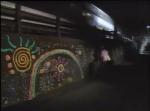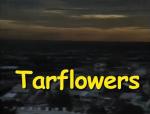AustLit
Latest Issues
AbstractHistoryArchive Description
Kev and Big Dog do their rounds every day, collecting scraps from the neighbourhood garbage bins and then beautifying the suburb with murals. Four-year-old Mary likes to help, but Mary will soon have to go to school. Kev decorates the schoolyard with tarflower murals, to the horror of the school authorities. But just as they're about to punish Kev, the tarflowers burst into life, so everyone can see their magic.
According to Patricia Edgar,
The film was to be shot on videotape as the special effects would have been expensive to produce on film. [...] When I came to Sydney to check on the production, Tom was worried about the coverage the director was achieving. Every scene was filmed in a long take, with no close-ups; the director said it was a personal style, but it meant that, when the scenes came together, the film was about thirty minutes longer than it should have been. The only way to shorten it was to cut out scenes completely, and then the film didn't make sense. I had to sack the director and try to make sense of the footage we had. Anne Brooksbank was brought in to write a narration to unify the film. Geoff Bennett, who had done well with On Loan and was available at very short notice, became a consultant director.
Source: Patricia Edgar, Bloodbath: A Memoir of Australian Television, Melbourne: Melbourne UP, 2006, p.169.
Notes
-
Telemovie.
-
The promotional trailer for this film is available to watch via YouTube: http://www.youtube.com/watch?v=W5TpNC6du3g&feature=plcp (Sighted: 8/8/2012)
Affiliation Notes
-
Writing Disability in Australia
Type of disability Intellectual disabilities (unspecified). Type of character Primary. Point of view Third person.





